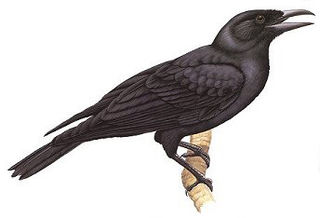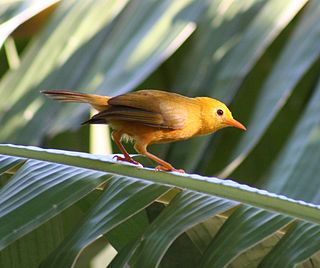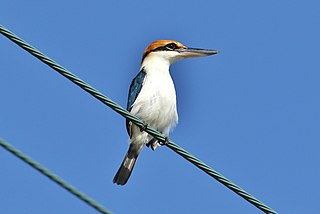
The Hawaiian crow or ʻalalā is a species of bird in the crow family, Corvidae, that is currently extinct in the wild, though reintroduction programs are underway. It is about the size of the carrion crow at 48–50 cm (19–20 in) in length, but with more rounded wings and a much thicker bill. It has soft, brownish-black plumage and long, bristly throat feathers; the feet, legs, and bill are black. Today, the Hawaiian crow is considered the most endangered of the family Corvidae. They are recorded to have lived up to 18 years in the wild, and 28 years in captivity. Some Native Hawaiians consider the Hawaiian crow an ʻaumakua.

The common moorhen, also known as the waterhen or swamp chicken, is a bird species in the rail family (Rallidae). It is distributed across many parts of the Old World, from Africa to Europe and Asia.

The spotted owl is a species of true owl. It is a resident species of old-growth forests in western North America, where it nests in tree hollows, old bird of prey nests, or rock crevices. Nests can be between 12 and 60 metres high and usually contain two eggs. It is a nocturnal owl which feeds on small mammals and birds. Three subspecies are recognized, ranging in distribution from British Columbia to Mexico. The spotted owl is under pressure from habitat destruction throughout its range, and is currently classified as a near-threatened species.

The Guam rail is a species of flightless bird in the Rallidae family, endemic to the United States territory of Guam. It is known locally as the ko'ko' bird. It was extirpated from the entire island by the late 1980s owing to the predation of the brown tree snake, an invasive species not native to the island.

The brown tree snake, also known as the brown catsnake, is an arboreal rear-fanged colubrid snake native to eastern and northern coastal Australia, eastern Indonesia, Papua New Guinea, and many islands in northwestern Melanesia. The snake is slender, in order to facilitate climbing, and can reach up to 2 meters in length. Its coloration may also vary, some being brown, green, or even red. Brown tree snakes prey on many things, ranging from invertebrates to birds, and even some smaller mammals. It is one of the very few colubrids found in Australia, where elapids are more common. Due to an accidental introduction after the events of World War II, this snake is now infamous for being an invasive species responsible for extirpating the majority of the native bird population in Guam. Currently, efforts are being made to reduce and control the population on Guam and prevent the snake from spreading to other locations.

Todiramphus is a genus of kingfishers in the subfamily Halcyoninae that are endemic to the Philippines, New Guinea, Australia, New Zealand and many islands in the South Pacific.

The Pacific Islands Conservation Research Association (PICRA) is a U.S. federally recognized 501(c)3 nonprofit organization. PICRA has a mission of advancing knowledge about insular Pacific species, populations, and ecosystems through unbiased scientific investigations. Research focuses on improving knowledge about islands and the conservation issues that insular fauna face. Results from PICRA’s work are intended for use in the development of applied and theoretical solutions to conservation problems.

The Mariana crow is a species of the crow family from the tropical Western Pacific. It is a glossy black bird about 15 inches (38 cm) long and known only from the islands of Guam and Rota.

The collared kingfisher is a medium-sized kingfisher belonging to the subfamily Halcyoninae, the tree kingfishers. It is also known as the white-collared kingfisher, black-masked kingfisher or mangrove kingfisher. It has a wide range extending from the Red Sea across southern Asia to Polynesia. A number of subspecies and subspecies groups have been split from this species including the Pacific kingfisher, the islet kingfisher, the Torresian kingfisher, the Mariana kingfisher, and the Melanesian kingfisher.
The Niau kingfisher is a species of bird in the family Alcedinidae. It is endemic to the island of Niau in French Polynesia. Its natural habitats are subtropical or tropical dry forests, plantations and rural gardens. Only 125 individuals remain in the wild. The Niau kingfisher is a multicolored, with bright blue feathers, a dusty orange head, and a bright green back. The entire population of these birds lives in Niau, and without serious intervention, they will likely become extinct.

The flat-billed kingfisher is a species of bird in the family Alcedinidae. It is endemic to Samoa.

The golden white-eye is a species of bird in the white-eye family, Zosteropidae. It is the only species within the genus Cleptornis. The golden white-eye was once considered to be a honeyeater in the family Meliphagidae and although it is now known to be a white-eye, its position within that family is still uncertain. The species is restricted to the islands of Saipan and Aguijan in the Northern Mariana Islands, where it is sympatric and competes with the related bridled white-eye. The golden white-eye has golden plumage and a pale eye-ring. It feeds on insects, fruit, and nectar and forages in pairs or small family groups. The bird is monogamous and lays two eggs in a small cup nest.

The Tahiti monarch, or Tahiti flycatcher, is a rare species of bird in the monarch flycatcher family. It is endemic to Tahiti in French Polynesia. There are between 25 and 100 individuals remaining with an increasing population trend. Adults boast a striking black plumage with pale blue pills and feet. Recognized for its melodious flute-like song and distinctive "tick-tick-tick" call, it thrives in dense forest, primarily inhabiting canopy and understory amidst native mara trees. Despite facing threats from introduces predators such as ship rats and invasive bird species, conservation efforts have been implemented to safeguard its population.
Robert E. Beck Jr. was a zoologist and conservationist, who worked to save Guam's indigenous native birds from 1982 to 2003. Beck championed the fight to save Guam's native birds, such as the Mariana crow, rufous fantail, Guam flycatcher, Guam kingfisher and the Guam rail, known locally as ko'ko' in Chamorro, which are under the extreme threat of extinction due to the non-native brown tree snake and habitat loss. The rufous fantail and the Guam flycatcher listed above are now extinct in the wild in their native Guam. However, the captive and wild populations of the Mariana crow, Guam rail and the Micronesian kingfisher have increased, due in large part to conservation efforts by Beck.

The Pohnpei kingfisher is a species of bird in the family Alcedinidae. It is endemic to Pohnpei. Its natural habitat is subtropical or tropical moist lowland forests. It was formerly considered to be a subspecies of the Micronesian kingfisher.

The Guam National Wildlife Refuge is composed of three units: the Andersen Air Force Base Overlay Unit, the Navy Overlay Unit, and the Ritidian Unit. The Ritidian Unit, known to the native CHamoru people as Puntan Litekyan, is located on the northern tip of Guam and encompasses approximately 1,217 acres, including 385 terrestrial acres and 832 acres of submerged areas offshore.

The rusty-capped kingfisher or Palau kingfisher is a species of bird in the family Alcedinidae. It is endemic to Palau. The natural habitat of this species is subtropical or tropical moist lowland forests. It was formerly considered to be a subspecies of the Micronesian kingfisher.
Micronesian kingfisher is a common name used to refer to several species of bird of the genus Todiramphus found in neighboring island countries of the western Pacific Ocean.
The islet kingfisher is a species of bird in the family Alcedinidae.















